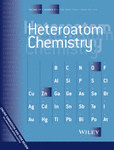Syntheses of Chiral Phosphazenes with Stereogenic Centers: NMR Behavior in the Presence of a Chiral Solvating Agent
ABSTRACT
The condensation reactions of tetrachloro mono (1 and 2) and bisferrocenyl spirocyclotriphosphazenes (3–5) with morpholine in tetrahydrofuran gave the partly morpholino-substituted ferrocenylphosphazenes. When the reactions were carried out with equal amounts of 1–5 and morpholine, the mono-substituted ferrocenylphosphazenes (1a, 3a–5a) formed as the major product. While the reactions were made with 1 equiv of 1–5 and 2 equiv of morpholine, the corresponding geminal–phosphazenes (1b–5b) were isolated. In addition, the condensation reactions of 1 equiv of 1–5 and 3 equiv of morpholine resulted in the formation of di-(1b–5b), tri-(2c–5c), and tetra-substituted phosphazenes. The tri-substituted compounds were isolated as major products. Some new phosphazenes have stereogenic P center(s). The stereogenic properties of 1a and 2c were investigated using 31P nuclear magnetic resonance (NMR) spectroscopy in the presence of the chiral solvating agent; (S)-(+)-2,2,2-trifluoro-1-(9′-anthryl)ethanol. The structures of all the phosphazenes were characterized by one-dimensional 1H, 13C, and 31P NMR, and two-dimensional heteronuclear single quantum coherence spectral data. The salient spectral properties of the phosphazenes were presented.




